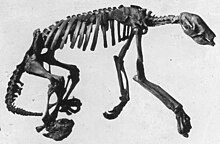Nothrotheriidae
| Nothrotheriidae Temporal range: 11.6–0.011 Ma Late Miocene to Late |
|
|---|---|
 |
|
| Shasta ground sloth (Nothrotheriops shastense), Peabody Museum | |
| Scientific classification | |
| Kingdom: | Animalia |
| Phylum: | Chordata |
| Class: | Mammalia |
| Order: | Pilosa |
| Suborder: | Folivora |
| Family: |
†Nothrotheriidae (Ameghino, 1920) C. Muizon et al., 2004 |
| Genera | |
|
see text |
|
see text
Nothrotheriidae is a family of extinct ground sloths that lived from approximately 11.6 mya—11,000 years ago, existing for approximately 11.49 million years. The nothrotheres have recently been moved from the tribe Nothrotheriini or subfamily Nothrotheriinae within Megatheriidae to their own family, Nothrotheriidae. Nothrotheriids appeared in the Tortonian, some 11.6 million years ago, in South America. The group includes the comparatively slightly built Nothrotheriops, which reached a length of about 2.75 meters. While nothrotheriids were small compared to some of their megatheriid relatives, their claws provided an effective defense against predators, like those of larger anteaters today.
During the late Miocene and Pliocene, the nothrotheriid Thalassocnus of the west coast of South America became adapted to a shallow-water marine lifestyle.
The earliest nothrotheriid in North America was Nothrotheriops, which appeared at the beginning of the , about 2.6 Ma ago.Nothrotherium reached Mexico (Nuevo Leon) by the late Pleistocene.
The last ground sloths in North America belonging to Nothrotheriops died so recently that their dried subfossil dung has remained undisturbed in some caves, as if it were just recently deposited. One of the skeletons, found in a lava tube (cave) at Aden Crater, adjacent to Kilbourne Hole, New Mexico, still had skin and hair preserved, and is now at the Yale Peabody Museum. The American Museum of Natural History in New York City has a sample of dung with a note attached to it that reads "deposited by Theodore Roosevelt". The largest samples of Nothrotheriops dung can be found in the collections of the Smithsonian Museum.
...
Wikipedia
